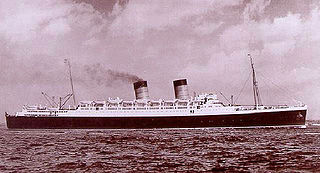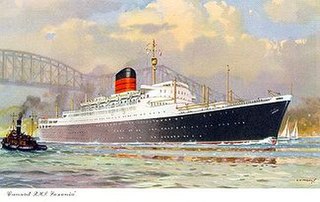
Cunard is a British shipping and cruise line based at Carnival House at Southampton, England, operated by Carnival UK and owned by Carnival Corporation & plc. Since 2011, Cunard and its three ships have been registered in Hamilton, Bermuda.

An ocean liner is a type of passenger ship primarily used for transportation across seas or oceans. Ocean liners may also carry cargo or mail, and may sometimes be used for other purposes. Only one ocean liner remains in service today.

A passenger ship is a merchant ship whose primary function is to carry passengers on the sea. The category does not include cargo vessels which have accommodations for limited numbers of passengers, such as the ubiquitous twelve-passenger freighters once common on the seas in which the transport of passengers is secondary to the carriage of freight. The type does however include many classes of ships designed to transport substantial numbers of passengers as well as freight. Indeed, until recently virtually all ocean liners were able to transport mail, package freight and express, and other cargo in addition to passenger luggage, and were equipped with cargo holds and derricks, kingposts, or other cargo-handling gear for that purpose. Only in more recent ocean liners and in virtually all cruise ships has this cargo capacity been eliminated.
Queen Victoria has been the name of several ships:

RMS Caronia was a 34,183 gross register tons (GRT) passenger ship of the Cunard Line. Launched on 30 October 1947, she served with Cunard until 1967. She was nicknamed the "Green Goddess" after her light green hull livery. She was one of the first "dual-purpose" ships, built both for 2-class transatlantic crossings and all 1st-class cruising. After leaving Cunard she was briefly Caribia in 1969, after which she was laid up in New York until 1974, when she was sold for scrap. While being towed to Taiwan for scrapping, she was caught in a storm on 12 August. After her tow lines were cut, she repeatedly crashed on the rocky breakwater outside Apra Harbor, Guam and broke into three sections.

RMMV Oceanic was the planned name of an unfinished ocean liner that was partially built by Harland and Wolff for the White Star Line. It would have been the third ship bearing the name Oceanic, after the one of 1870 and the one of 1899. It was envisaged in 1926, with the idea of modernizing the transatlantic service of the company. With the arrival of Lord Kylsant at the head of the company, the planned size of the project increased, until it became that of a large ship destined to be the first to exceed the symbolic limit of 1,000 feet (305 m) in length and 30 knots in speed.

The RMS Mauretania was an ocean liner that was launched on 28 July 1938 at the Cammell Laird yard in Birkenhead, England, and was completed in May 1939. She was one of the first ships built for the newly formed Cunard-White Star company following the merger in April 1934 of the Cunard and White Star Line. On the withdrawal of the first Mauretania in 1935, to prevent a rival company using the name and to keep it available for the new liner, arrangements were made for the Red Funnel paddle steamer Queen to be renamed Mauretania in the interim.

RMS Caronia was a Cunard Line transatlantic steam ocean liner. She was launched in 1904 and scrapped in 1932. In World War I she was first an armed merchant cruiser (AMC) and then a troop ship.

RMS Carmania was a Cunard Line transatlantic steam turbine ocean liner. She was launched in 1905 and scrapped in 1932. In World War I she was first an armed merchant cruiser (AMC) and then a troop ship.

MS Vistafjord was an ocean liner that was built as a combined liner/cruise ship in 1973 by Swan Hunter Shipbuilders in the United Kingdom for the Norwegian America Line. In 1983 she was sold to Cunard Line, retaining her original name until 1999 when she was renamed Caronia. In 2004 she was sold to Saga and sailed as Saga Ruby until sold in 2014 for use as a floating hotel and renamed Oasia. This never came to fruition. Her owners went bankrupt, and in April 2017 she arrived at Alang, India for scrapping.

RMS Saxonia was a British passenger liner built by John Brown & Company at Clydebank, Scotland for the Cunard Steamship Company for their Liverpool-Montreal service. She was the first of four almost identical sister ships built by Browns between 1954 and 1957 for UK-Montreal service. The first two of these ships, Saxonia and Ivernia were extensively rebuilt in 1962/3 as dual purpose liner/cruise ships. They were renamed Carmania and Franconia respectively and painted in the same green cruising livery as the Caronia. Carmania continued transatlantic crossings and cruises until September 1967 when she closed out Cunard's Montreal service. She and her sister had been painted white at the end of 1966 and from 1968 Carmania sailed as a full time cruise ship until withdrawal after arriving at Southampton on 31 October 1971. In August 1973 she was bought by the Soviet Union-based Black Sea Shipping Company and renamed SS Leonid Sobinov. The ship was scrapped in 1999.

RMS Sylvania was an ocean liner built in 1957 by John Brown & Co (Clydebank), in Glasgow, for the United Kingdom-based shipping company Cunard Line. She was the last Cunard Line vessel built specifically for transatlantic crossings. The ship was later heavily rebuilt as a cruise ship, and sailed under the names SS Fairwind, SS Sitmar Fairwind, SS Dawn Princess and SS Albatros before being scrapped in 2004. She was renamed SS Genoa for her last voyage.

RMS Ivernia was a Saxonia class ocean liner, built in 1955 by John Brown & Company in Clydebank, Scotland for Cunard Line, for their transatlantic passenger service between the UK and Canada. In 1963 she was rebuilt as a cruise ship and renamed RMS Franconia, after the famous pre-war liner RMS Franconia. She continued to sail for Cunard until being withdrawn from service and laid up in 1971. In 1973 she was sold to the Soviet Union's Far Eastern Shipping Company and, renamed SS Fedor Shalyapin, cruised around Australia and the far East. In 1980 she was transferred to the Black Sea Shipping Company fleet, and for a time returned to cruising in the Mediterranean and around Europe. In 1989 she was transferred again, to the Odessa Cruise Company, and continued her career as a cruise ship until 1994. She was then laid up at Illichivsk, a Black Sea port 40 km southwest of Odesa, until 2004 when, as the Salona, she sailed to Alang, India, where she was scrapped.

RMS Carinthia was an ocean liner built in 1956 as one of the four Saxonia class ships. She sailed for Cunard Line from her completion until 1968 when she was sold to Sitmar Line, rebuilt into a full-time cruise ship and renamed SS Fairsea. She sailed with Sitmar until 1988, when Sitmar was sold to P&O. She was renamed SS Fair Princess and sailed for Princess Cruises and P&O Cruises until 2000. She was then sold to China Sea Cruises and renamed SS China Sea Discovery. In 2005 or 2006 she was scrapped in Alang, India.

RMS Queen Mary 2 is a British transatlantic ocean liner. She has served as the flagship of Cunard Line since succeeding Queen Elizabeth 2 in 2004. As of 2017, Queen Mary 2 is the only ocean liner in service.

The RMS Franconia was an ocean liner operated by the Cunard Line from 1922 to 1956. The liner was second of three liners named Franconia which served the Cunard Line, the others being RMS Franconia built in 1910 and the third Franconia in 1963.

The first RMS Saxonia was a passenger ship of the British Cunard Line. Between 1900 and 1925, Saxonia operated on North Atlantic and Mediterranean passenger routes, and she saw military service during World War I (1914–1918).

Sir James Gordon Partridge Bisset, CBE, RD was a British merchant sea captain who served as Commodore of the Cunard White Star Line (1944–47). He documented his fifty-year sea career in a three volume autobiography: Sail Ho! My Early Years at Sea (1958); Tramps and Ladies – My Early Years in Steamers (1959) and Commodore – War, Peace and Big Ships (1961). In addition, Bisset authored Lifeboat Efficiency (1924) which became the primary text used by the British Merchant Marine until the Second World War for instructing merchant seaman in lifeboat utilization and handling, and Ship Ahoy ! : Nautical Notes for Ocean Travellers (c.1930), a treatise on shipboard operations for the edification of passengers. He served in or commanded Cunard liners including Carpathia, Caronia, Franconia, Mauretania, Aquitania, Berengaria, Queen Mary and Queen Elizabeth.

RMS Parthia was the second of two all first class transatlantic passenger cargo liners built for the Cunard Line. She later served on the London to Auckland route for the New Zealand Shipping Company under the name Remuera, and still later as a Pacific cruise ship under the name Aramac. She was scrapped in 1969–70.
MS Queen Anne is a cruise ship under construction for Cunard Line.

















